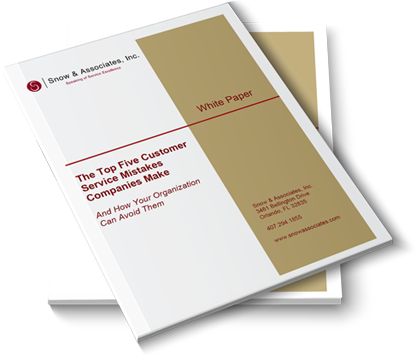
The Top Five Customer Service Mistakes That Companies Make
And How Your Organization Can Avoid Them.
Posted on May 23, 2008 by Dennis Snow
Some of you are aware that I’ve been working on a new book, Lessons From the Mouse, based on my 20-years working at Walt Disney World. The book is due to be published this summer and I’m truly excited about it. It covers the ten key lessons I learned as a Disney cast member and helps readers apply those lessons to their own organizations, careers, and lives.
With my next ten blog posts, I’d like to share a synopsis of each lesson that Lessons From the Mouse covers. My hope is that you’ll find these brief descriptions to be beneficial – and I also hope these descriptions whet your appetite so that you’ll buy the book when it comes out!
Lesson #1: Never Let Backstage Come Onstage
The concepts of “onstage” and “backstage” are critical to preserving the Disney magic. Imagine a child actually seeing Cinderella smoking a cigarette. Years of therapy might be called for. Or imagine seeing a maintenance truck near the Frontierland train station – it doesn’t really fit the frontier theme, does it? Such disconnects would destroy the illusion that Disney has spent billions to create. As cast members, protecting the magic is a key part of the job.
No matter the organization, there is a brand image you want customers to have in mind. And that brand image can quickly be compromised by violating Lesson #1. Clearly distinguishing “onstage” from “backstage,” and keeping the two completely separate, helps to preserve the integrity of your brand. Even a seemingly harmless action like leaving a stockroom door open can create a “visual intrusion” when customers can clearly see all of the stockroom clutter. Or notes and memos about employee policies taped up on the wall in full view of customers. Do customers really need to know that returning late from a break may result in disciplinary action?
And backstage isn’t just a physical place; it’s also an attitude. We’ve all overheard employees discussing things that have no business being discussed onstage. Customers don’t want to hear employees discussing last night’s keg party or hear employees complaining to each other about their supervisor. Most customers are annoyed when they have to get the attention of an employee whose head is buried in a magazine. Each of these perfectly natural employee behaviors belongs backstage where they don’t interfere with the customer experience.
Here are three questions for you to think about as you consider Lesson #1: